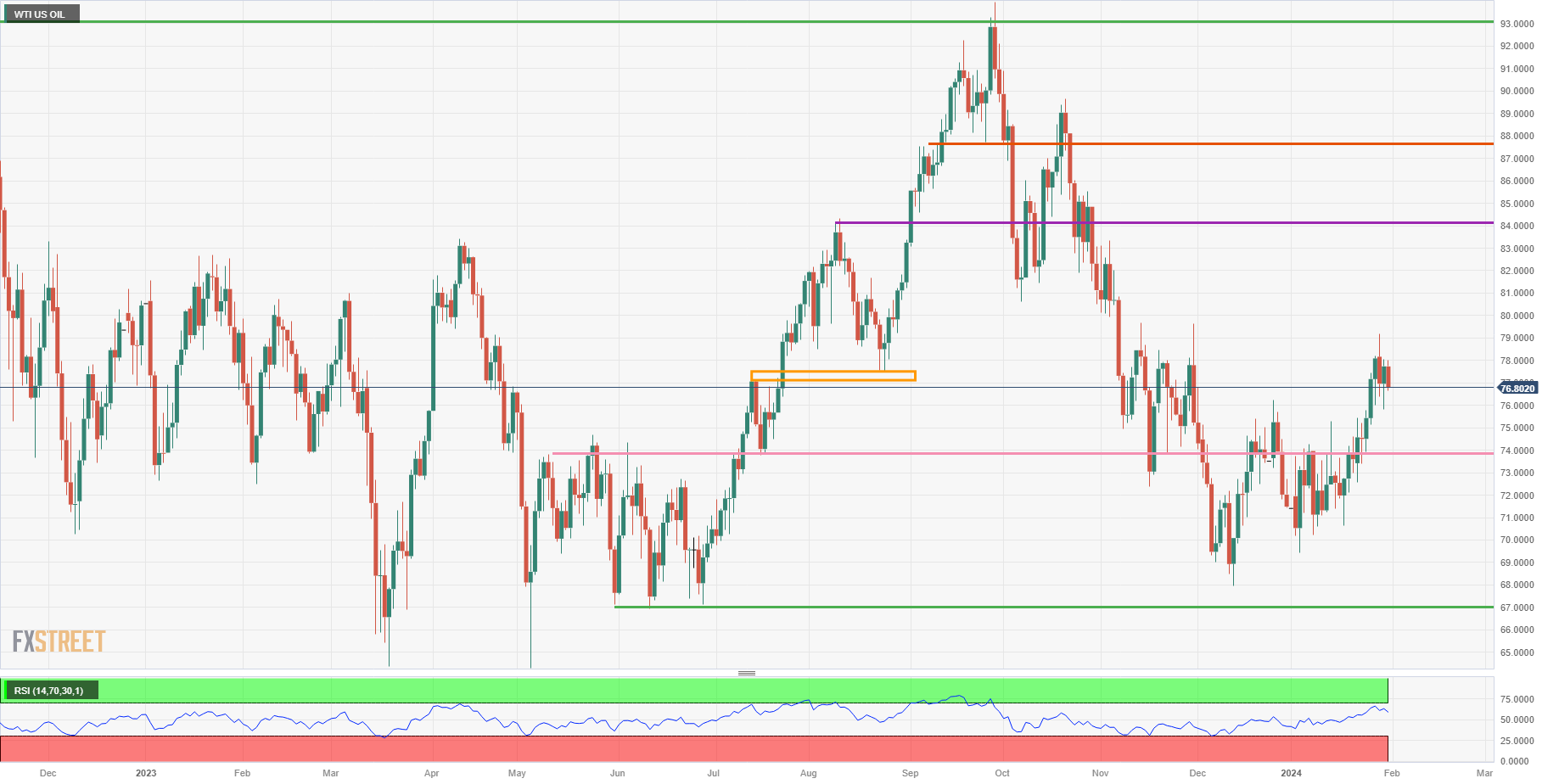Oil sinks over 1% with US ADP miss on estimates and Venezuela in focus
- WTI Oil popped to nearly $80 as the US threatened to reimpose sanctions on Venezuela.
- Oil is still finding its way to importers through other producers.
- The US Dollar Index firms ahead of the first Federal Reserve rate decision for 2024.
Oil prices are seeing a pickup in volatility on Wednesday, jumping towards the $80 psychological level, as the US said it stands ready to issue new sanctions against the Venezuelan Oil industry. With this move, The US appears to be leveraging political democratic elections in the Latin American country, after the leader of the opposition party got blocked by a court decision, barring Maria Corina Machado from the election.
Meanwhile, the US Dollar Index (DXY, is stuck in a tight technical range that has been underway for nearly two weeks now. With the first US interest-rate decision from the US Federal Reserve due later on Wednesday, markets will be plucking the speech from Chairman Jerome Powell for clues if March or rather June is the right moment for a first rate cut. The US Jobs Report, due on Friday, is also expected to cause a pickup in volatility..
Crude Oil (WTI) trades at $76.90 per barrel, and Brent Oil trades at $81.70 per barrel at the time of writing.
Oil news and market movers: OPEC vs US
- Saudi Arabia is considering reviving an Aramco share sale.
- Overnight numbers from the American Petroleum Institute (API) showed a drawdown of 2.49 million barrels last week.
- At 15:30 GMT, the Energy Information Administration (EIA) is due to release its weekly stockpile change number. Previous was a draw of 9.233 million barrels, while a much smaller draw of 217,000 is expected.
- Two tankers carrying Russian Oil have been reported to be on their way to India to offload their cargo.
- Saudi Arabia has cancelled its plans to look into a production increase. The news was not picked up amidst the COP28 headlines. However, the kingdom is refraining from jacking up production as the US has substantially scaled up its exports.
Oil Technical Analysis: support to hold for now
Oil prices tend to react to any possible disruption in the Oil market. US sanctions on Venezuela would trigger a supply deficit in the current market, sending oil prices up. This is something that the US really wants to avoid, which makes the US a barking dog that might not actually bite.
To the upside, resistance at $74 is in the rear view mirror and should act as support. Although price action came very near, $80 will not be easy to beat. Once $80 is broken, $84 is next on the topside.
The $74 level will act as immediate support on any sudden declines. The $67 level could still come into play as the next support as it aligns with a triple bottom from June. Should that triple bottom break, a new low could be close at $64.35 – the low of May and March 2023 – as the last line of defence.
US WTI Crude Oil: Daily Chart
WTI Oil FAQs
WTI Oil is a type of Crude Oil sold on international markets. The WTI stands for West Texas Intermediate, one of three major types including Brent and Dubai Crude. WTI is also referred to as “light” and “sweet” because of its relatively low gravity and sulfur content respectively. It is considered a high quality Oil that is easily refined. It is sourced in the United States and distributed via the Cushing hub, which is considered “The Pipeline Crossroads of the World”. It is a benchmark for the Oil market and WTI price is frequently quoted in the media.
Like all assets, supply and demand are the key drivers of WTI Oil price. As such, global growth can be a driver of increased demand and vice versa for weak global growth. Political instability, wars, and sanctions can disrupt supply and impact prices. The decisions of OPEC, a group of major Oil-producing countries, is another key driver of price. The value of the US Dollar influences the price of WTI Crude Oil, since Oil is predominantly traded in US Dollars, thus a weaker US Dollar can make Oil more affordable and vice versa.
The weekly Oil inventory reports published by the American Petroleum Institute (API) and the Energy Information Agency (EIA) impact the price of WTI Oil. Changes in inventories reflect fluctuating supply and demand. If the data shows a drop in inventories it can indicate increased demand, pushing up Oil price. Higher inventories can reflect increased supply, pushing down prices. API’s report is published every Tuesday and EIA’s the day after. Their results are usually similar, falling within 1% of each other 75% of the time. The EIA data is considered more reliable, since it is a government agency.
OPEC (Organization of the Petroleum Exporting Countries) is a group of 13 Oil-producing nations who collectively decide production quotas for member countries at twice-yearly meetings. Their decisions often impact WTI Oil prices. When OPEC decides to lower quotas, it can tighten supply, pushing up Oil prices. When OPEC increases production, it has the opposite effect. OPEC+ refers to an expanded group that includes ten extra non-OPEC members, the most notable of which is Russia.


